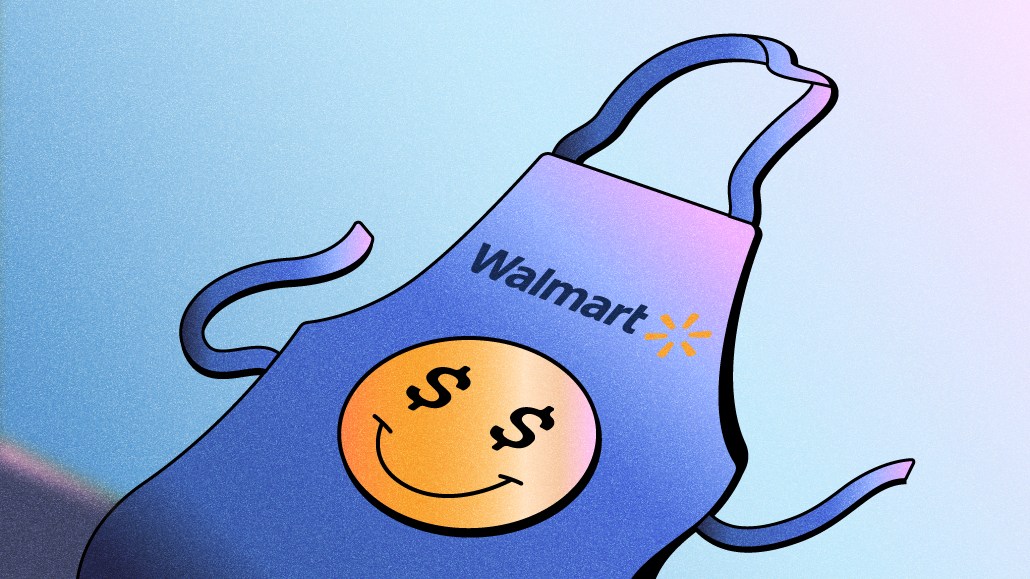Advertisers shift retail media spending beyond Amazon to include Walmart, Target and more

Ever since Tinuiti’s retail media arm sprouted up from the digital wilds a decade ago, its bosses were bombarded with one singular chant from advertisers: “Amazon, take my money.” That was the alpha and omega of their retail media game plan.
Fast forward to about six months ago, and something odd happened: Those same advertisers flipped the script.
They started nudging Tinuiti’s execs to spend their ad dollars not just on Amazon, but across a whole spectrum of platforms.
These days, it’s a rarity for Elizabeth Marsten, Tinuiti’s vp of commerce strategic services, to engage in advertiser discussions that circle solely around Amazon. The trend has shifted toward a more inclusive approach, roping in Walmart, Target, Instacart, and an ever-expanding list of platforms.
These aren’t just a few outliers Marsten’s talking about. This shift is catching on with about a quarter of the agency’s clientele.
Still yet — Amazon isn’t getting the cold shoulder and bags the bulk of their ad budgets even as it’s sharing the stage with a growing ensemble of retailers.
Spending on these additional platforms — Walmart, Target, and the like — is experiencing double-digit growth this year, surpassing Amazon’s advertising growth, albeit from a lower base, Marsten said but declined to given specific percentages.
This trend isn’t limited to Tinuiti and its advertisers.
At global retail media and marketplace Macarta, for example, ad spending on retail media owners beyond Amazon is projected to surge by 25% to 30% this year compared to 2023, while on Amazon, the growth rate is pegged at 10%.
The same goes for advertising ad digital agency Markacy. Retail media ad spending outside of Amazon is projected to grow by 20% this year for its advertisers, whereas the pace for Amazon is expected to remain essentially flat.
Bit by bit, retail advertising is stepping out of Amazon’s shadow.
Amazon spend grows — as it does with its competitors
“Retail media has been synonymous with Amazon but 2024 will probably be the year that this link starts to fade,” said Jared Belsky, CEO of digital agency Acadia. “The investment chips, at least from our clients, are starting to flow into Walmart, Instacart, Kroger, Chewy, Ulta and more.”
This diversification, initially slow, has become more pronounced, with non-Amazon retail advertising spending for the agency’s clients expected to grow by 13% this year on $100 million pot, up from 7% last year.
Walmart, in particular, appears to be driving much of this growth. According to Belsky, Acadia’s clients saw their ad spending on the retailer increase by 45% between the third and fourth quarters of last year.
Looks like all those advertising upgrades Walmart’s been peddling over the last 18 months or so are finally paying off. Spending there grew faster than any retail media ad platform last year for Acadia’s advertisers.
As Belsky explained: “Walmart for us grew 104% [in 2023], Target was 56% and then the smaller retail media businesses together grew around 200%.”
Other agency executives interviewed for this article echoed — anecdotally — the same sentiment and said that after Amazon, Walmart is swiftly emerging as the top player in retail media.
Here’s how Amy Rumpler, svp of search and social media services at Basis Technologies, put it: It’s too early to predict how much each partner’s spend will grow this year, but over the last 12 months Walmart has been growing at a faster pace than Amazon. However, overall spend on Amazon is still much higher than on Walmart at this time, continued Rumpler.
There are several reasons for this, including the fact that ad prices on Walmart’s retail media can be up to 40% cheaper than Amazon, thanks to the lack of competition.
But what might be even more crucial is the potential to ramp up spending with established, commercially influential partners.
This is particularly true in the CPG realm, where a CMO must meet a certain spending threshold with a retailer to secure prime placement in stores. Those stakes aren’t really there when they advertise on Amazon. How much they spend there isn’t potentially going to make or break their company’s stock price.
Why Walmart is winning out — for now
“Walmart matters in CPG and grocery,” said Belsky. “Spending there isn’t just going to drive returns through Walmart Connect for businesses there. When they spend that money they’re also influencing their merchant or line review exec.”
So, it’s no wonder that some of these CMOs are putting more of their ad dollars into Walmart than Amazon. It just makes sense, as one agency executive put it. Even so, it’s probably only a handful of marketers making this move right now. Most are still trying to comprehend how much they should be throwing into retail media, let alone where to throw it.
Regardless, Amazon’s not exactly sweating bullets here.
While ad spending there may not be surging at the same meteoric rates as elsewhere, with Acadia noting a 22% increase in 2023, it’s essential to put these numbers into perspective. Amazon’s advertising business is a colossal $44.9 billion empire, dwarfing Walmart’s $3.2 billion operation. Comparing the two is akin to juxtaposing a lion with a kitten — they’re simply not on the same scale.
Yet, it’s clear that all players, big and small, are benefiting from the retail media boom sweeping across the industry, each carving out their slice of the pie from different sectors. Notably, traditional areas like shopper marketing and TV have been long standing arteries for this shift in spending.
Programmatic is another source of ad dollars for retail media, though newer and less entrenched than those other two.
Chalk this up to the industry’s adaptation to the phasing out of third-party cookies in Chrome.
As Belsky explained: “There’s a world emerging where more and more people are looking for high-fidelity data in advance of cookie depreciation.”
When faced with a situation like this, few options rival turning to retailers. Amazon, Walmart et al.
These giants possess a treasure trove of first-party data, including each customer’s transaction history, thanks to mandatory login requirements for purchases. This data is invaluable for targeting, especially as traditional cookie-based methods become less reliable.
It’s hard to say how much this is quickening the pace of advertising on retail media now. There’s definitely some impact on spending, but there’s also a whole lot of uncertainty swirling around. What will advertisers do once those cookies crumble? The answer’s about as clear as mud — vague and complicated.
What’s crystal clear, though, is that the hunt for top-notch “high-fidelity data” that Belsky mentioned earlier is making marketers sit up and take notice of the full scope of the retail media market like never before.
Including retail media in ‘omnichannel’ approaches
A case in point is Danone, where global head of media and brand communications Catherine Lautier has been waving the flag for investing more in retail media, using the promise of primo data as one of her main selling points to the higher-ups.
“Within the ecosystem of a retail media partner you’re able to target specific consumers who are going to be open to your category, which is a very important aspect for us,” continued Lautier. “We’ve never been able to do that sort of targeting with cookies. They never got us to that level of behavior.”
But here’s the twist — just because there’s a willingness to funnel more cash into retail media platforms doesn’t mean Danone — or any other advertiser for that matter — is going to throw all their eggs in that basket. In fact, they couldn’t even if they wanted to, not when so much of those dollars are tied up in internal fiefdoms and commercial commitments. And Lautier knows this all too well.
“The internal challenge for us is that the money we are spending with retailers sits across different teams, from marketing to sales to e-commerce so it’s hard to make sure what we do spend is the best use of that money,” she continued. “We’re trying to change that because when you get that alignment right, retail media can have much more of an impact thanks to the close loop attribution there.”
What she’s really getting at is setting the stage for ad dollars to find their true purpose. An operation where Danone’s marketers ditch the old rigid guidelines like “TV for brand” and “digital for performance” in favor of something more flexible — something that embraces the idea that ads can do pretty much anything marketers dream up, as long as they’re crafted and measured the right way.
Making changes of this magnitude isn’t for the faint of heart. It takes marketers with serious clout who can rally support from the bigwigs in the C-suite, not to mention the dedication to see it through. After all, this isn’t the kind of transformation they nail in five months — it’s more like a five-year marathon.
“The path of omnichannel is not short nor easy because in a lot of cases it requires massive reorganization and the bigger you are, the harder that is,” said Tinuiti’s Marsten. “That said, there are a few large global organizations that are gearing up to do just that. I know because I’ve seen the RFPs and RFIs.”
Getting to this point, where talks of omnichannel budgets and retail media are becoming more than just pipe dreams, has been a long haul.
For years, it was all met with skepticism. Budgets were modest at best. But they gained traction as marketers adopted a test-and-grow approach to advertising on retail media. Now, it’s becoming some of the more bankable parts of their media plans.
“We expect retail marketplace growth to continue to accelerate and individual grocers/retailers will continue to invest in these capabilities to meet customers where they are shopping,” said Chris Jones, co-CEO of Markacy.
More in Marketing

‘Still not a top tier ad platform’: Advertisers on Linda Yaccarino’s departure as CEO of X
Linda Yaccarino — the CEO who was never really in charge.

Questions swirl after X CEO Linda Yaccarino departs from the platform
Her departure marks the end of two tumultuous years at the platform.

Creator marketing has the reach — CMOs want the rigor
The creator economy got big enough to be taken seriously.










